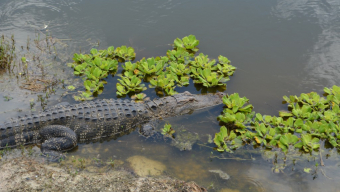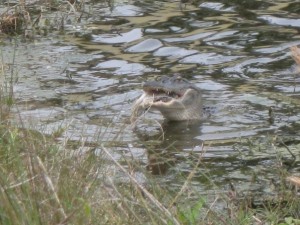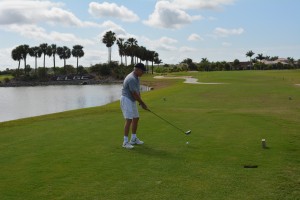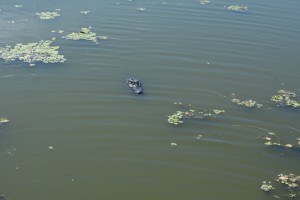MARCO ISLAND, Fla. – Golf is played outdoors, among the trees, meadows, waterways and things that can kill you.
More than a few courses around the world are habitats for big mouths with big teeth. Depending on the region, there are wolves, coyote, big cats prowling courses. The club that I belong near Seattle has two black bear families living in the woods just off the fairways, one group on the front nine and one on the back. They have been spotted from time to time swaggering across the driving range, to the alarm and delight of the members.
In Arizona, there are signs that warn golfers to stay out of certain wayward areas because rattlesnakes wrap around the tumbleweed. Out of ignorance and cheapness, I have frequently ventured in those areas to retrieve my balls, with a keen eye and a long club held well out in front of me so that if there’s a strike it’s on my hosel, not my ankle.
A week ago we saw Spanish golfer Pablo Larrazabal jump into a pond during the Malaysian Open to avoid being strung by some anger hornets.
This past week during the televised coverage of the Zurich Classic of New Orleans there were plenty of shots of the huge alligators floating menacingly among the
ponds. Host Jim Nance talked about ‘Tripod’, a giant gator with three legs who rules the waterways around the course.
Gator are the most threatening of all the golf course mascots because they can strike quickly, overpower their prey and swallow you whole. We’ve heard of gator encounters with golfers over the years, with some golfer pulled into the drink to their deaths, some losing an leg or arm and many fending off attacks with a precise wedge to the head.
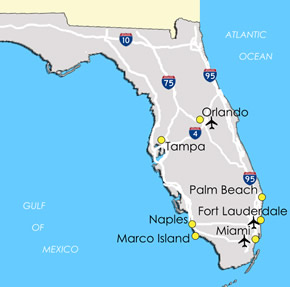 With family in Southwest Florida, I’ve seen plenty of gators during my visits on the courses in the Naples-Marco Island area. I’ve played more than a dozen courses in that region and it’s rare when you don’t see a gator lurking, sunning or grinning. There are said to be 1.5 million alligators in Florida.
With family in Southwest Florida, I’ve seen plenty of gators during my visits on the courses in the Naples-Marco Island area. I’ve played more than a dozen courses in that region and it’s rare when you don’t see a gator lurking, sunning or grinning. There are said to be 1.5 million alligators in Florida.
I’ve seen one alligator capturing a unlucky cormorant and chomping him down in one gulp. I’ve seen giant ones, 16- to 18-feet, laying motionless on the edge of a pond and within a few yards of my drive (I need more length). I’ve seen them surreptitiously stalking me with eyes just above the water. I saw one with his mouth slightly open and his legs cocked, seemingly ready for a quick rush at me. I gave him his space.
Two weeks ago, I played a course that was said to be teeming with alligators. It’s called Eagle Lakes, a decent tract among lakes and houses just off the backside of Marco Island. Eagle Lakes is the last golf course on the west coast of Florida before entering the Everglades. Just about anything south of the course is alligator habitat – swamps, mangroves and airboats.
Eagle Lakes has at least one pond on every hole, some on both sides of the fairway. By my count, there are 34 water hazards on the course. This includes several parallel holes so the pond on your right on one hole will be on your left on the next.
And alligators are in every pond. You may not see them, but they see you.
The first hole is notorious for gator sightings, with a 150-yard pond just to the left of the tee complex. This was the second time I’ve played the course and I still haven’t seen one there.
As you progress, you’ll begin to spot them, a head bobbing in the distance or a dark shape on a far bank. Standing on the No. 3 green waiting to putt, I glanced to the pond adjacent to the hole and my first sighting approached the bank. He was about a 14-footer with most of the top of his body exposed as he swam. But when I walked over to take a picture, he stopped and lowered himself into the cloudy water, with just a portion of his head exposed. His eye were fixed on me. I had his attention and he had mine.
Just about all the encounters with gators are benign, otherwise the starter wouldn’t keep sending people into harm’s way. Attacks are rare. They are not out there poised to pounce once you turn your back. They know you can run away quicker than they can catch you. They also see the club in your hand to keep them at bay.
Also, many of the ponds are six or eight feet below the embankments so it would be difficult for an attacking gator to climbing that bank with any sort of speed.
Eagles Lakes, which also has a pair of nesting bald eagles on the course, weaves around the water hazards with abundant landing areas. Our threesome lost a few balls into the water, bad hacks, mostly, and without a thought of retrieval.
The back nine, traditionally, has most creatures and we found that to be true. We saw a good size gator weaving his way along the bank in the pond to the left of the par-3 12th hole. There were others out there, heads above the water as we drove our carts just yards away from the water.
It wasn’t until the 18th hole where we saw a bounty, with several navigating the waterways. Just after our drives, we took our carts alongside a long pond and encountered a short but dangerous-looking gator just below us. It was about 8- to 10-feet long (pictured at the top) and five feet down the embankment. It was aware of us but offered no threat, just a poser for the camera.
No. 18 is a terrific hole. It’s a par-5, 576-yarder with a pond that runs along the entire length of the hole on the left side. Your drive needs to be steered a little right to left to avoid a bunker about 200 straight out. It’s a long second shot for most of us and there’s a tall tree about 70 yards in front of the green. It’s right in the way.
My third shot was an attempt to take my ball to the left of the tree but it drifted toward the pond and dribbled in.
When I reached my ball you could see it the water, about three inches deep and 18 inches off the bank. My first thought was ‘this is how it happens. This is how you lose a leg.’ The water was murky and fairly deep. If I wanted that ball – and I did – I’d have to risk a potential gator strike, from any direction. Where would it come from? How quick would it be? How would I react? Is the ball worth it?
I wasn’t going to let a gator attack cost me a pristine Callaway. I reach for a 7-iron to give me some extension as well as some scooping action. I stretched that iron over the water, eying either side, checking for any kind of turbulence. It was a stubborn dig but I brought it back, flipped it on the bank and scooted away.
No encounters this time but alligators can live up to 40 years in the wild. They’ll all be there when I tee it up again, lurking.





